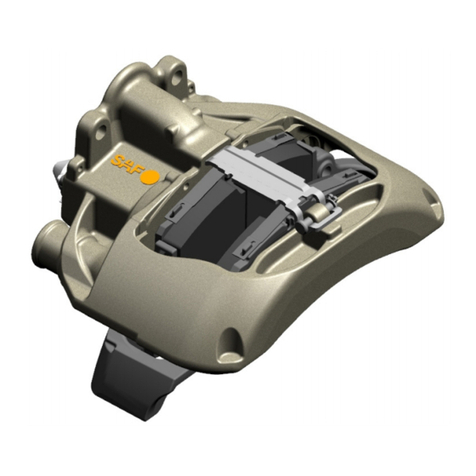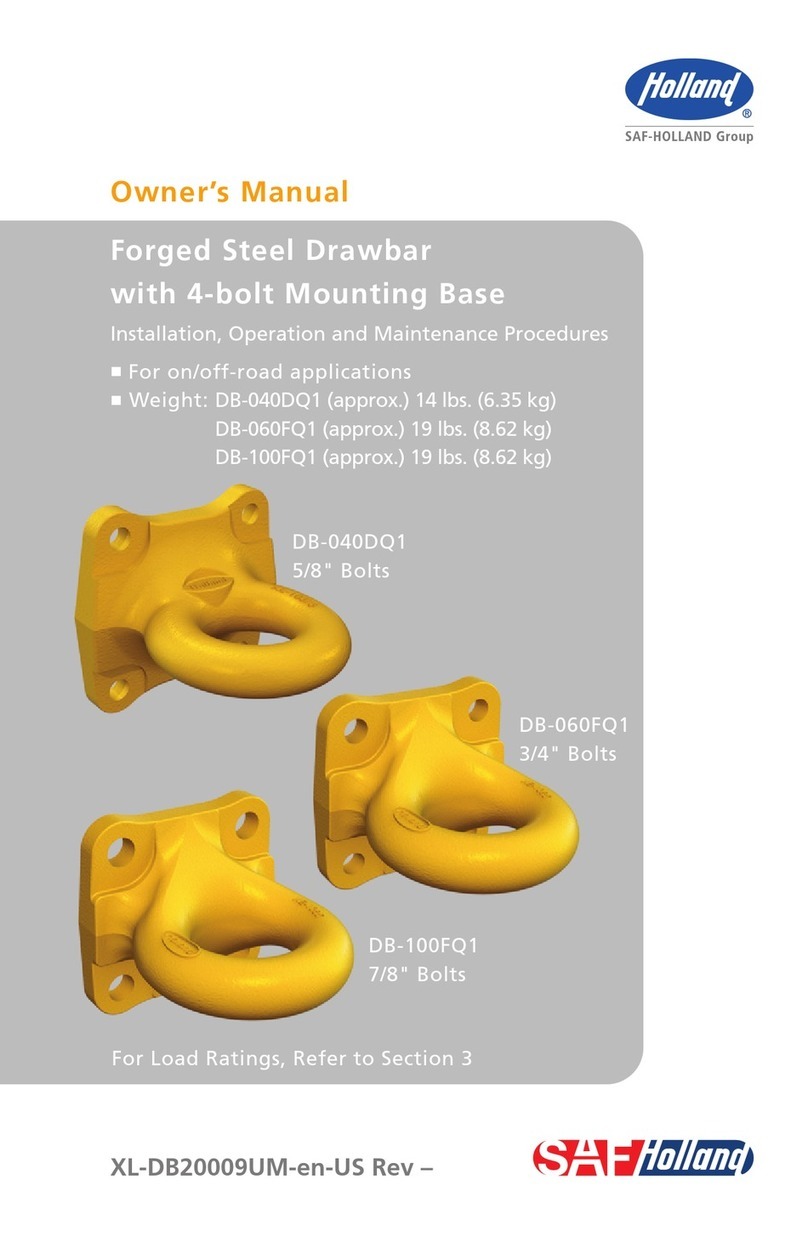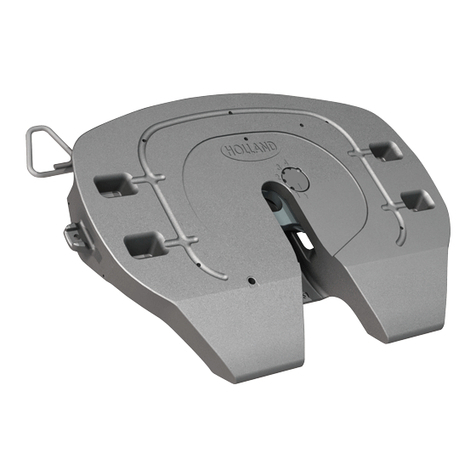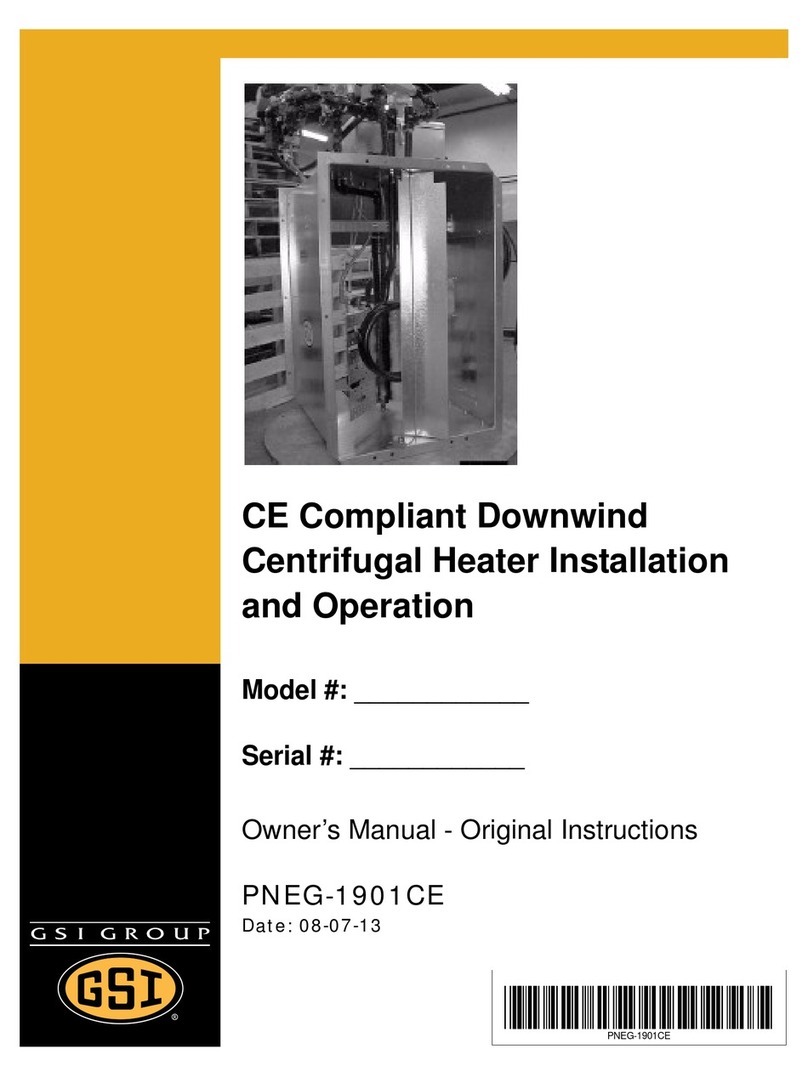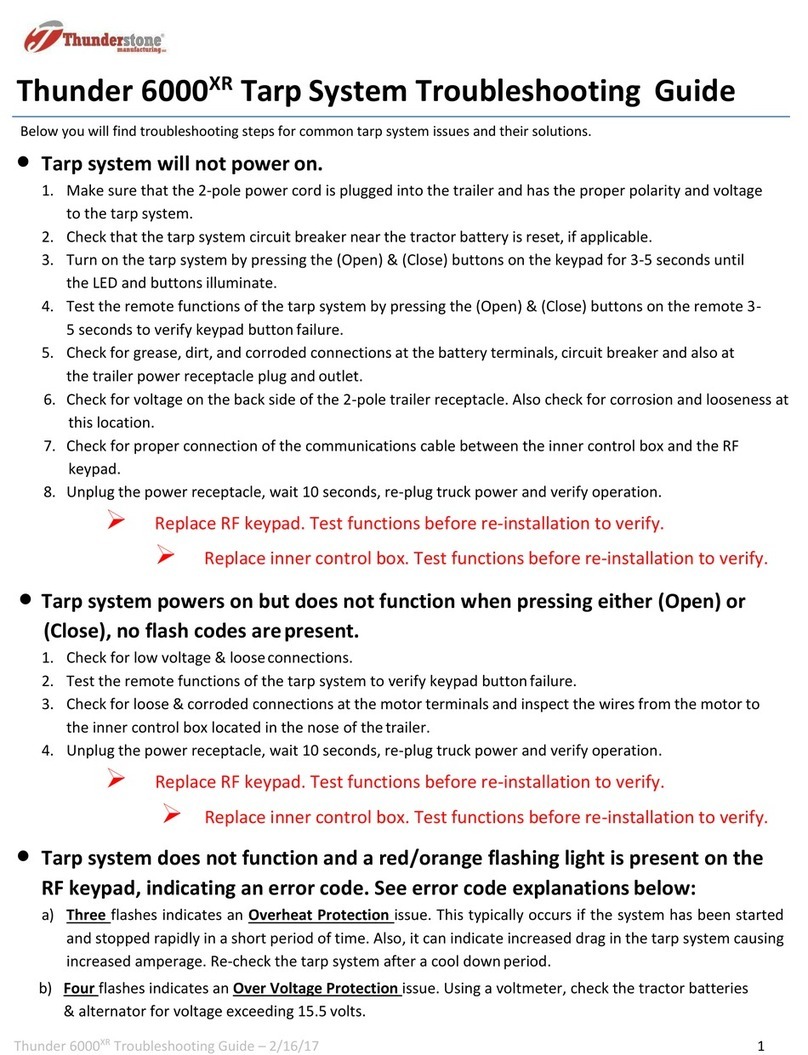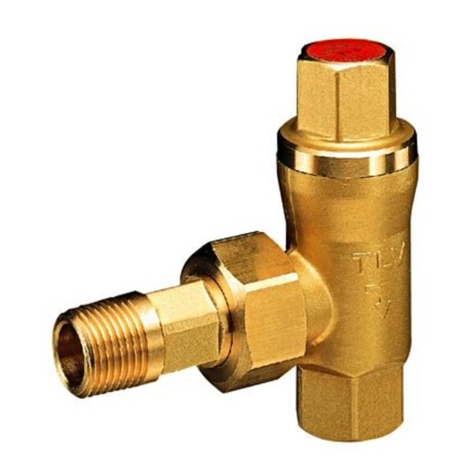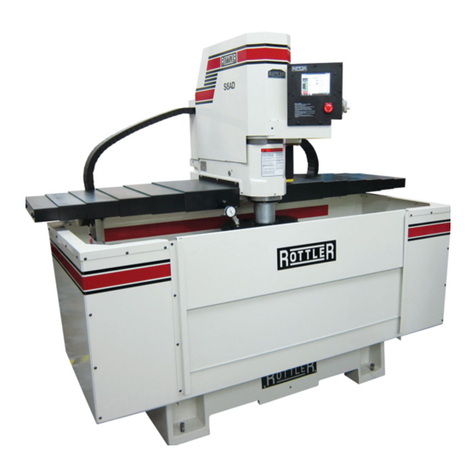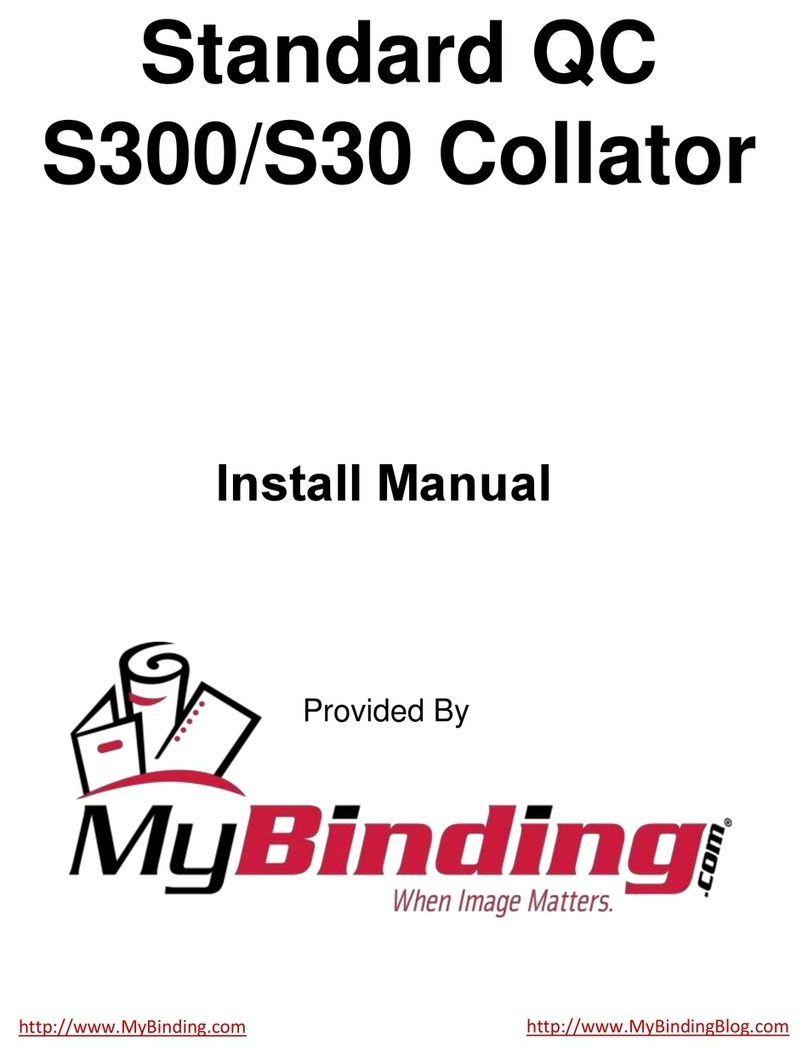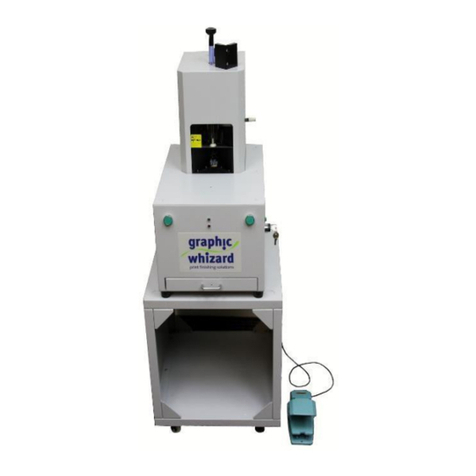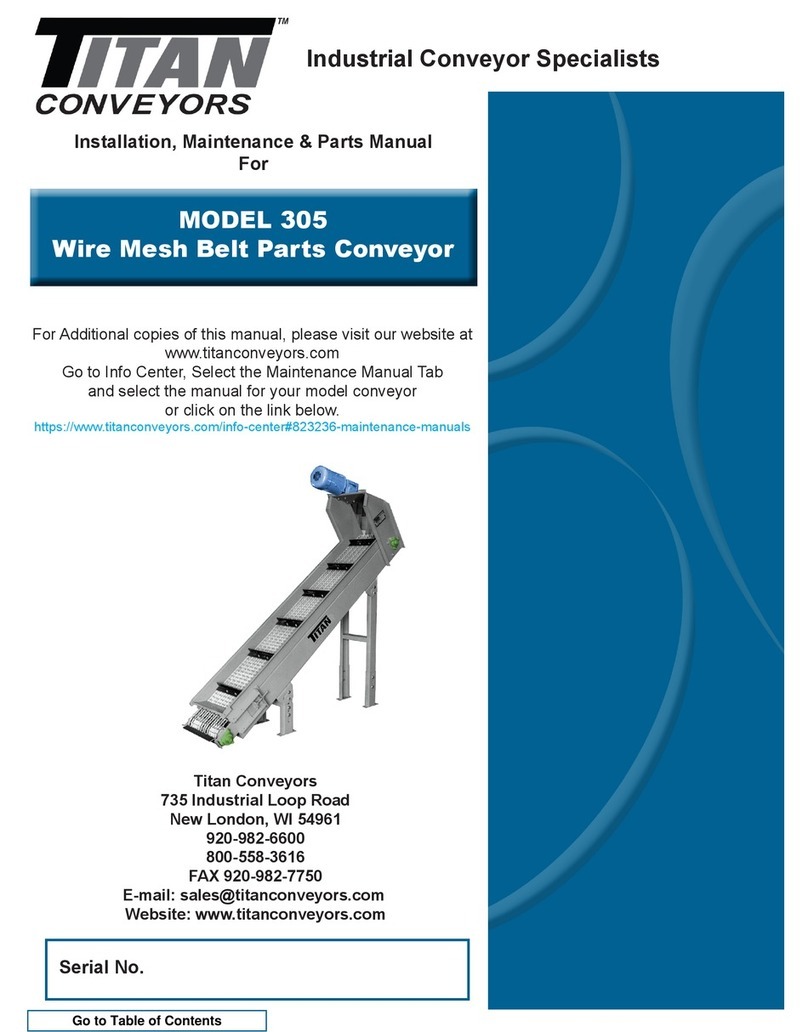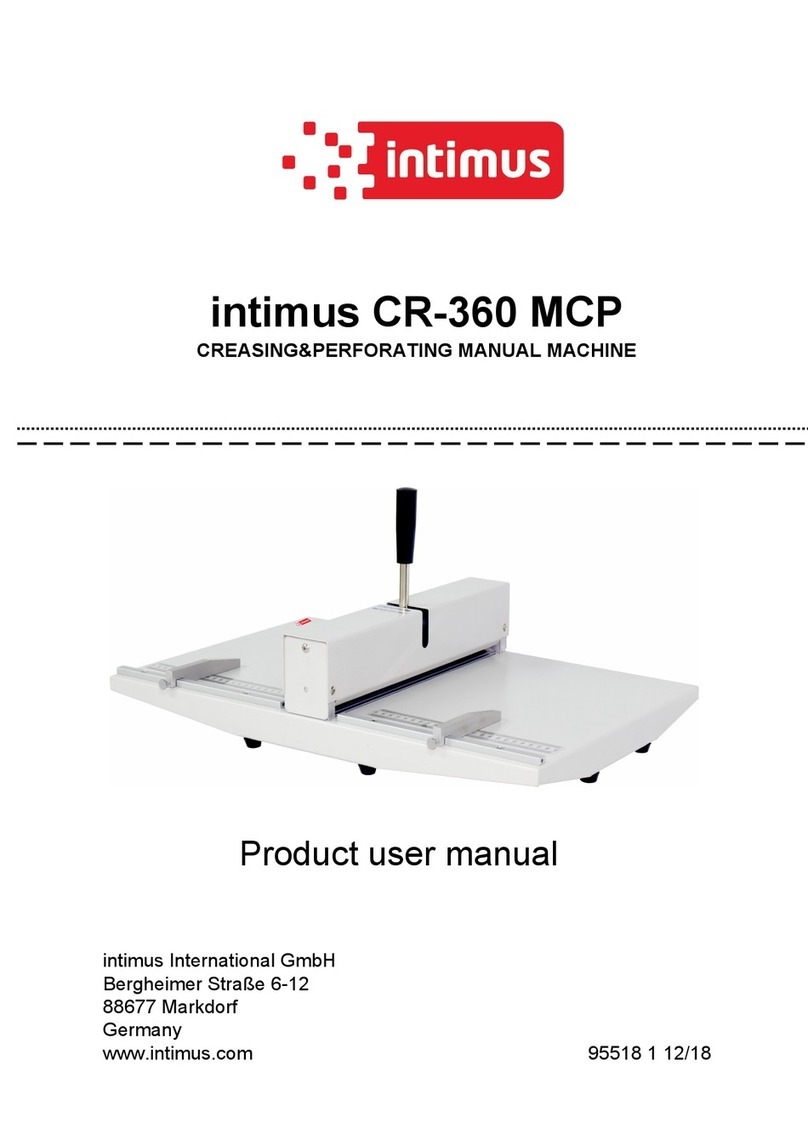SAF-HOLLAND CBXAS Series User manual

XL-AS20100BM-en-US
Installation and Operation Manual
CBXAS Suspension Series
Fixed Frame Top Mount Trailer Air Suspension
For Disc and Drum Brake Applications
23,000 lb, 25,000 lb, and 30,000 lb Capacities

2XL-AS20100BM-en-US · 2020-12-21 · Amendments and Errors Reserved · © SAF-HOLLAND, Inc., SAF-HOLLAND, HOLLAND, SAF,
and logos are trademarks of SAF-HOLLAND S.A., SAF-HOLLAND GmbH, and SAF-HOLLAND, Inc.
Contents
Contents Page
Introduction......................................................................... 2
Warranty.............................................................................. 2
Notes, Cautions, and Warnings............................................. 2
Section 1 – General Safety Instructions ................................ 3
Section 2 – Standard Decal Requirements ............................ 5
Section 3 – CBXAS Series Model Identification .................... 6
Section 4 – CBXAS Series Model Nomenclature.................... 6
Section 5 – Welding Standards............................................. 7
Introduction
This manual provides information necessary for the installation
and operation of the SAF-HOLLAND®30 Series fixed frame top
mount trailer air suspension.
The CBXAS Series suspensions include premium 5.75" diameter
axles. For axle end and/or brake servicing information or
component replacements, refer to XL-SA20018UM-en-US - P89 NEW
and XL-SA20024UM-en-US - P89 PLUS or contact Customer
Service at 888-396-6501.
This suspension uses air drawn from the tractor air system to
pressurize the air springs. The height control valve (HCV) regulates
the air pressure required for varying loads while maintaining the
design ride height. This suspension can provide a cushioned ride
throughout the load range, from empty to fully loaded.
The suspension also provides excellent side-to-side and
axle-to-axle loading which helps equalize and control braking.
Read this manual before using or servicing this product and
keep it in a safe location for future reference. Updates to this
manual, which are published as necessary, are available on
the internet at www.safholland.us.
When replacement parts are required, SAF-HOLLAND highly
recommends the use of only SAF-HOLLAND Original Parts. A
list of technical support locations that supply SAF-HOLLAND
Original Parts and an Aftermarket Parts Catalog are available
on our website at www.safholland.us.
Warranty
Refer to the complete warranty for the country in which
the product will be used. A copy of the written warranty is
included with the product or available on the internet at
www.safholland.com.
Notes, Cautions, and Warnings
Before starting any work on the unit, read and understand all
the safety procedures presented in this manual. This manual
contains the terms “NOTE”, “IMPORTANT”, “CAUTION”, and
“WARNING” followed by important product information. These
terms are defined as follows:
NOTE: Includes additional information to enable accurate
and easy performance of procedures.
IMPORTANT: Includes additional information that
if not followed could lead to hindered
product performance.
Used without the safety alert symbol,
indicates a potentially hazardous
situation which, if not avoided, could
result in property damage.
Indicates a potentially hazardous
situation which, if not avoided, could
result in minor or moderate injury.
Indicates a potentially hazardous
situation which, if not avoided, could
result in death or serious injury.
Contents Page
Section 6 – Standard Air Control System Installation ............ 8
Section 7 – Suspension Assembly Installation....................... 9
Section 8 – Ride Height Adjustment ................................... 10
Section 9 – SwingAlign™ Axle Alignment .......................... 12
Section 10 – Brake Adjustment Instructions........................ 13
Section 11 – Pre-Operation Information ............................. 14
Section 12 – Maintenance and Service Schedule................. 15
Section 13 – Torque Specifications ..................................... 16

3
XL-AS20100BM-en-US · 2020-12-21 · Amendments and Errors Reserved · © SAF-HOLLAND, Inc., SAF-HOLLAND, HOLLAND, SAF,
and logos are trademarks of SAF-HOLLAND S.A., SAF-HOLLAND GmbH, and SAF-HOLLAND, Inc.
General Safety Instructions
1. Safety Instructions
General and Servicing Safety Instructions
Read and observe all Warning and Caution hazard alert
messages. The alerts provide information that can help
prevent serious personal injury, damage to components,
or both.
Failure to follow the instructions and
safety precautions in this manual could
result in improper servicing or operation
leading to component failure which, if
not avoided, could result in death or
serious injury.
All maintenance should be performed by a properly
trained technician using proper/special tools, and
safe procedures.
NOTE: In the United States, workshop safety
requirements are defined by federal and/or state
Occupational Safety and Health Act (OSHA).
Equivalent laws could exist in other countries.
This manual is written based on the assumption
that OSHA or other applicable employee safety
regulations are followed by the location where
work is performed.
Properly support and secure the vehicle from unexpected
movement when servicing the unit.
Failure to properly support and secure
the vehicle and axles prior to commencing
work could create a crush hazard which,
if not avoided, could result in death or
serious injury.
If possible, unload the trailer before performing any
service procedures.
After re-positioning the brake chamber, slack adjuster
and/or ABS system as instructed in this manual, always
consult the manufacturer’s manual for proper operation.
Service both roadside and curbside of an axle. Worn parts
should be replaced in sets. Key components on each
axle’s braking system, such as friction material, rotors
and drums will normally wear over time.
Follow all manufacturer’s instructions on spring pressure
and/or air pressure controls.
Failure to follow manufacturer’s
instructions regarding spring pressure or
air pressure control could allow
unexpected release of energy which, if
not avoided, could result in death or
serious injury.
DO NOT paint the wheel contact surfaces between the
wheel and hub.
IMPORTANT: The wheel contact surfaces MUST be
clean, smooth and free from grease.
Failure to keep wheel and hub contact
surfaces clean and clear of foreign
material could allow wheel/hub
separations which, if not avoided, could
result in death or serious injury.
Only the wheel and tire sizes approved by the trailer
builder can be used.
continued

4XL-AS20100BM-en-US · 2020-12-21 · Amendments and Errors Reserved · © SAF-HOLLAND, Inc., SAF-HOLLAND, HOLLAND, SAF,
and logos are trademarks of SAF-HOLLAND S.A., SAF-HOLLAND GmbH, and SAF-HOLLAND, Inc.
General Safety Instructions
1. Safety Instructions continued
Operational and Road Safety Instructions
Before operating vehicle, ensure that the maximum
permissible axle load is NOT exceeded and that the load
is distributed equally and uniformly.
Make sure that the brakes are NOT overheated from
continuous operation.
Failure to minimize the use of brakes
during overheating conditions could
result in deterioration of brake efficiency
which, if not avoided, could result in
death or serious injury.
The parking brake MUST NOT be immediately applied
when the brakes are overheated.
If the parking brake is immediately
applied to the brakes when overheated,
the brake drums or discs could be
damaged by different stress fields
during cooling.
Observe the operating recommendation of the trailer
manufacturer for off-road operation of the installed axles.
IMPORTANT: The definition of OFF-ROAD means driving
on non-asphalt/non-concrete routes, e.g.
gravel roads, agricultural and forestry
tracks, on construction sites and in
gravel pits.
IMPORTANT: Off-road operation of axles beyond
the approved application design could
result in damage and impair suspension
system performance.
Follow the recommended routine maintenance and
inspections described in this manual. These procedures
are designed so that optimum performance and
operational safety are achieved.
In the event of suspension air pressure loss, quickly
reduce speed as safely as possible and remove the
vehicle from traffic. If unable to remove vehicle from
traffic, follow DOT safety requirements regarding
emergency situations.
Contact a qualified towing and/or service company to
assist in repairing the vehicle or to move it to a qualified
repair facility. DO NOT operate the vehicle in the absence
of suspension air pressure; however in the event of an
air system failure while in service, an internal composite
bumper built into the air spring will make it possible
to temporarily operate the vehicle at reduced speed
determined by road conditions.
Operating the vehicle without proper
air pressure can cause tire failure, fire,
or loss of vehicle control which, if not
avoided, could result in death or
serious injury.

5
XL-AS20100BM-en-US · 2020-12-21 · Amendments and Errors Reserved · © SAF-HOLLAND, Inc., SAF-HOLLAND, HOLLAND, SAF,
and logos are trademarks of SAF-HOLLAND S.A., SAF-HOLLAND GmbH, and SAF-HOLLAND, Inc.
Decal Requirements
2. Standard Decal Requirements
The following three (3) decals MUST be properly installed on
the trailer prior to putting it in service:
Tire Clearance Warning Decal: XL-AR356-01 (Figure 1).
SwingAlign Axle Alignment Decal: XL-AR435 (Figure 2).
Torque Decal: XL-AS20108DC-en-US (Figure 3).
Shear Bolt Decal: XL-AS20085DC-en-US (Figure 4).
It is the responsibility of the end user to periodically inspect all
decals and ensure that they are clean and completely legible.
If any decals are missing, loose, damaged or difficult to read,
contact SAF-HOLLAND Customer Service at 888-396-6501 to
order replacements immediately.
This suspension has been installed with a shear bolt front pivot connection design. This
connection requires no torque check, but does REQUIRE VISUAL INSPECTION.
Inspect that the spline has been sheared off and for any signs of movement:
Prior to placing trailer in service. At every routine preventative maintenance.
After three (3) months or 5,000 miles. At every brake relining.
DO NOT apply anti-sieze compound or additional lubricant
to pivot connection hardware. This can lead to unpredictable
clamp loads and unreliable axle alignment.
SHEAR BOLT −FRONT PIVOT CONNECTION SHEAR BOLT STYLES
XL-AS20085DC-en-US Rev A
www.safholland.us
Copyright © 2018 • SAF-HOLLAND
®
, Inc.
SPLINE TO SHEAR OFF
ONCE PROPER CLAMP
LOAD IS ACHIEVED
E-20 HEAD SPLINE
(AFTERMARKET)
TENSION CONTROL
(OEM)
WARNING
Minimum tire clearance MUST be maintained between tires and
nearest point of contact on the suspension or vehicle. Premature
tire wear, fire or loss of vehicle control could result from contact
with the tires if clearances are not maintained.
XL-AR356-01
TIRE CLEARANCE REQUIREMENTS
• 1 INCH (25.4 mm) MINIMUM VERTICAL tire clearance is required between the top of the tire
and the nearest point of contact above the tire when the air pressure is completely exhausted
from the air suspension or when the axle is fully lifted if equipped with a suspension lift feature.
• 2 INCH (50.8 mm) MINIMUM LATERAL tire clearance is required between the sides of the
tire and the nearest point of contact through total travel of the air suspension. This includes
when the wheels are fully turned in either direction if equipped with an SAF Self Steer Axle.
www.safholland.us
Copyright © 2011 • SAF-HOLLAND, Inc.
Figure 1
ALIGNMENT BOLT IS ON THE FRONT OF THE ROADSIDE FRAME BRACKET:
XL-AR435 Rev. B
STEP 1. To properly align the suspension, the trailer should be pulled in a straight line for a sufficient distance
to insure there are no binds in the suspension.
STEP 2. Check to verify trailer is empty and emergency brakes are NOTengaged.
STEP 3. Rotate bolt CLOCKWISE to move axle forward (A arrows); COUNTERCLOCKWISE to move axle rearward (B arrows).
A = axle forward
B = axle rearward
ALIGNMENT BOLT HEAD
NOTE: 1/2 turn of
free play in either
direction (A or B)
is acceptable.
SWING ALIGN®NON-WELDED AXLE ALIGNMENT PROCEDURES
www.safholland.us
Copyright © 2011 • SAF-HOLLAND, Inc.
Figure 2
Figure 4
Figure 3
Torques are with clean, lubricated threads.
Always apply torque to nut, if possible.
REQUIRED RE-TORQUING SCHEDULE:
All fasteners after first three (3) months or 5,000 miles.
At every routine preventative maintenance.
At every brake relining.
Fastener Size
Shock Air Spring SwingAlign
3/4" 1/2" 3/4" 1/2"
Torque
ft.-lbs.
(N•m)
140 - 175
(190-237)
30-40
(41-54)
40-45
(54-61)
50-60
(68-81)
CBXAN / CBXAS FIXED FRAME TRAILER AIR SUSPENSION TORQUE SPECIFICATIONS
XL-AS20108DC-en-US
www.safholland.us
Copyright © 2020 • SAF-HOLLAND®, Inc.

6XL-AS20100BM-en-US · 2020-12-21 · Amendments and Errors Reserved · © SAF-HOLLAND, Inc., SAF-HOLLAND, HOLLAND, SAF,
and logos are trademarks of SAF-HOLLAND S.A., SAF-HOLLAND GmbH, and SAF-HOLLAND, Inc.
Figure 6
Model Identification and Nomenclature
3. CBXAS Series Model Identification
The CBXAS Series suspension serial tag is located on the
frame bracket (Figure 5).
NOTE: This manual applies to the suspension models
listed on the front cover. However, determine the
specific model number, write that information
below and refer to it when obtaining information
or replacement parts (Figure 6).
NOTE: If the suspension serial tag is NOT legible or is
NOT available, it can identified by the appearance
of the equalizing beam (Figure 5). The CBXAS Series
model will have a cast beam with a shock
absorber mounted through it on a 5.75" axle
(Figure 5).
4. CBXAS Series Model Nomenclature
The sample tag illustrated will help interpret the information
on the SAF-HOLLAND Inc. serial number tag. The part number
is on the first line. The model number along with the
suspension capacity are on the second line. The third line
contains the serial number (Figure 5).
CB X AS 30 - 14
5.75" Diameter Premium Axle
Cast Beam Suspension
Suspension Capacity: 30,000 Lbs.
Axle Capacity: 25,000 Lbs.
Aero Beam Standard
Ride Height
14" (356 mm)
15" (381 mm)
16" (406 mm)
17" (432 mm)
Figure 5
TAG LOCATED ON
THE FRAME BRACKET

7
XL-AS20100BM-en-US · 2020-12-21 · Amendments and Errors Reserved · © SAF-HOLLAND, Inc., SAF-HOLLAND, HOLLAND, SAF,
and logos are trademarks of SAF-HOLLAND S.A., SAF-HOLLAND GmbH, and SAF-HOLLAND, Inc.
Welding Standards
5. Welding Standards
5.1 Scope
When welding is required for the suspension installation,
observe the requirements below. This specification applies to
all components supplied by SAF-HOLLAND, and its products.
The customer assumes all responsibility for weld integrity if
weld material and procedure differ from those listed below.
5.2 Workmanship
All welding on SAF-HOLLAND products MUST be performed by
a welder qualified according to the appropriate AWS standard
for the weld being made or an equivalent standard. It is the
responsibility of the customer to provide good workmanship
when welding on SAF-HOLLAND products.
5.3 Material
Items to be welded that are made from low carbon or
high-strength alloy steel are to be welded with AWS filler
metal specification AWS A5.18, filler metal classification
ER-70S-3, ER-70S-6 or equivalent unless specified on the
installation drawing.
NOTE: Any substitution for filler material from the above
standard must comply, as a minimum, with the
following mechanical properties:
Tensile Strength - 72k psi (496 MPa)
Yield Strength - 60k psi (414 MPa)
Charpy V Notch - 20 ft.-lbs. (27 N•m) at 0° F (-17.7° C)
% Elongation - 22%
The recommended welding gas for gas metal arc welding
(GMAW) is 90% Argon / 10% CO2. If a different gas is used,
welds must comply with penetration requirements illustrated
(Figure 7). Where the installation drawing specifies different
than above, the drawing shall prevail.
5.4 Procedures
Tack welds used for positioning components are to be located
in the center of the final weld, where practical. Tack weld
should be completely fused to the finish weld. DO NOT break
arc at the end of the weld. Back up all finish welds at least
1/2" (12.7 mm) or a sufficient amount to prevent craters at
the end of the weld. Where weld is illustrated to go around
corners, it is assumed the corner represents a stress
concentration area. DO NOT start or stop weld within
1" (25.4 mm) of the corner. Particular care should be taken
to prevent undercutting in this area.
5.5 Weld Size
If weld size is NOT specified, the effective throat of the weld
MUST be no smaller than the thinnest material being welded
(Figure 7).
LACK OF FUSION OF
ANY KIND IN THIS AREA
IS NOT ACCEPTABLE AT
ANY TIME
PENETRATION AS MEASURED
THROUGH SEAM
TARGET PENETRATION TO BE
10% OF THINNEST MATERIAL
FROM INTERSECTION OF FILLET
AS ILLUSTRATED
TARGET PENETRATION
Figure 7

8XL-AS20100BM-en-US · 2020-12-21 · Amendments and Errors Reserved · © SAF-HOLLAND, Inc., SAF-HOLLAND, HOLLAND, SAF,
and logos are trademarks of SAF-HOLLAND S.A., SAF-HOLLAND GmbH, and SAF-HOLLAND, Inc.
Installation Instructions
6. Standard Air Control
System Installation
The following is a typical air system installation and should
be plumbed as illustrated (Figure 8).
The air control system of the CBXAS Series suspensions use air
drawn from the tractor air system to pressurize the suspension’s
air springs. The suspension, working with the air control system,
provides optimum suspension performance only when all air
control system components are installed and operating properly.
IMPORTANT: Make certain that all air lines and valves
are free from obstruction through the full
operational range of the suspension.
IMPORTANT: A pressure protection valve (PPV) MUST
be attached to the air reservoir in order to
maintain proper air pressure (Figure 8).
IMPORTANT: The air pressure protection valve maintains
safe brake pressure.Approximately 85 psig
(5.9 bars) opens the valve, and 65 psig
(4.5 bars) closes the valve.
NOTE: When installing the pressure protection valve,
use a drop of oil or Loctite®to lubricate threaded
connections. DO NOT use a pipe compound or
teflon tape as they could clog the valve.
A height control valve (HCV) is used to regulate the air
pressure required for varying load capacities (Figure 8).
STANDARD AIR CONTROL SYSTEM
AIR RESERVOIR
PRESSURE PROTECTION
VALVE (PPV)
HEIGHT CONTROL
VALVE (HCV)
TO HEIGHT CONTROL
VALVE (HCV)
AIR SPRING
AIR SPRING
AIR SPRING
AIR SPRING
TO AIR SUPPLY
TO AIR SPRINGS
TO AIR SPRINGS
CONTROL ARM
(NEUTRAL POSITION)
Figure 8

9
XL-AS20100BM-en-US · 2020-12-21 · Amendments and Errors Reserved · © SAF-HOLLAND, Inc., SAF-HOLLAND, HOLLAND, SAF,
and logos are trademarks of SAF-HOLLAND S.A., SAF-HOLLAND GmbH, and SAF-HOLLAND, Inc.
Table 1
Installation Instructions
7. Suspension Assembly Installation
NOTE: Locate the suspension on the trailer frame. Refer
to your model’s specific installation drawing for
the proper weld patterns and locations. To obtain
a copy of your specific installation drawing,
contact SAF-HOLLAND Customer Service at
888-396-6501.
1. Once the suspension is correctly positioned, weld the
suspension in place as outlined in Section 5.
2. Ensure the linkage assembled to the height control valve
(HCV) and suspension is installed properly (Figure 9).
3. Install the service and emergency lines to the suspension
and allow the suspension to air up.
4. Measure the ride height of the suspension with a tape
measure (Figure 10).
5. Compare the measured suspension ride height value to
the appropriate value (Table 1). Ensure the measured
ride height value is within ± 1/4" (6 mm).
IMPORTANT: If the measured ride height value is NOT
within ± 1/4" (6 mm), follow the Ride
Height Adjustment procedures described
in Section 12.
6. Visually check all air control system fittings for air leaks
by applying a soapy water solution and checking for
bubbles at all air connections and fittings.
Figure 9
90° OR LESS
AT RIDE
HEIGHT
LINKAGE
CONTROL ARM
HEIGHT
CONTROL
VALVE
LOWER AXLE
MOUNTING
BRACKET
Figure 10
“A”
RIDE HEIGHT
“A” RIDE HEIGHT
14"
15"
16"
17"

10 XL-AS20100BM-en-US · 2020-12-21 · Amendments and Errors Reserved · © SAF-HOLLAND, Inc., SAF-HOLLAND, HOLLAND, SAF,
and logos are trademarks of SAF-HOLLAND S.A., SAF-HOLLAND GmbH, and SAF-HOLLAND, Inc.
Figure 12
Ride Height Adjustment
8. Ride Height Adjustment
IMPORTANT: Trailer MUST be unloaded before
beginning any service procedures.
1. On a level surface, support the front of the trailer with
either a kingpin stand, landing gear, or while coupled to
a tractor (Figure 11).
2. Raise the trailer frame approximately 2" (51 mm) above
the suspension’s specified ride height (Figure 12).
3. Place multiple jack stands at the suspension’s specified
ride height (Table 2) under the vehicle frame at
OEM specified locations, then lower the trailer onto the
jack stands.
Failure to properly support the suspension
during maintenance could create a crush
hazard which, if not avoided, could result
in death or serious injury.
Table 2
“A” RIDE HEIGHT
14"
15"
16"
17"
4. Exhaust all air from the suspension, set the parking
brakes, and chock the wheels.
Failure to exhaust the suspension air
and chock the tires prior to beginning
maintenance could allow vehicle
movement which, if not avoided, could
result in death or serious injury.
5. Disconnect the linkage from the control arm and lower
the axle mounting bracket (Figure 13).
6. Pin the height control valve so that the valve arm is in
the center or neutral position (Figure 13).
Figure 11
SUPPORT AT KINGPIN
“A” RIDE
HEIGHT
FIFTH WHEEL
OPERATING HEIGHT
“A”
RIDE HEIGHT
Figure 13
LINKAGE
CONTROL ARM
HEIGHT
CONTROL
VALVE
LOWER AXLE
MOUNTING
BRACKET
90° OR LESS AT
RIDE HEIGHT

11
XL-AS20100BM-en-US · 2020-12-21 · Amendments and Errors Reserved · © SAF-HOLLAND, Inc., SAF-HOLLAND, HOLLAND, SAF,
and logos are trademarks of SAF-HOLLAND S.A., SAF-HOLLAND GmbH, and SAF-HOLLAND, Inc.
Ride Height Adjustment
7. Measure distance “B” between the valve arm and mounting
bracket holes to determine linkage length (Figure 14).
8. Adjust the linkage to required length and install the hardware
into the upper and lower connections (Figure 14).Torque
hardware to 30-40 in.-lbs. (3-5 N•m).
NOTE: It could be necessary to cut linkage rod to
achieve proper length. Be sure to de-burr rod to
prevent link end damage.
9. Raise the trailer approximately 2" (50 mm) above the
ride height and remove the jack stands.
10. Slowly lower the trailer so that the trailer suspension is
fully collapsed.
11. Pull the pin and apply air to the trailer allowing the
suspension to return to ride height.
12. With the suspension at rest, measure the ride height.
Ride height MUST be within 1/4" (6 mm) of the
suspensions specified ride height.
13. Spray a soapy water mix on all air line connections to
check for air leaks and verify fittings are tight.
IMPORTANT: It is the responsibility of the air system
installer to secure all air lines and check
for air leaks. If air leaks are detected,
repair as required.
Failure to eliminate air leaks could
compromise the suspension performance
which, if not avoided, could result in
component or property damage.
14. Remove the wheel chocks.
Figure 14
B
LINKAGE
CONTROL ARM
HEIGHT
CONTROL
VALVE
LOWER AXLE
MOUNTING
BRACKET

12 XL-AS20100BM-en-US · 2020-12-21 · Amendments and Errors Reserved · © SAF-HOLLAND, Inc., SAF-HOLLAND, HOLLAND, SAF,
and logos are trademarks of SAF-HOLLAND S.A., SAF-HOLLAND GmbH, and SAF-HOLLAND, Inc.
Installation Instructions
9. SwingAlign™ Axle Alignment
9.1 Alignment Preparation
1. Pull the trailer in a straight line for a sufficient distance
to ensure that there are no binds in the suspension.
2. Disengage the trailer parking brakes and make sure the
trailer is empty.
3. Manually measure or use an optical device specifically
designed for alignment measuring to determine
the following:
a. Measure the distance from the kingpin to the centerline
of the front axle spindles. It is recommended that the
spindle extensions be utilized.
b. Dimensions A and B (Figure 15) MUST be equal to
within 1/8" (3 mm).
c. Measure the distance from the centerline of the front
axle spindles to the centerline of the rear axle spindles.
d. Dimensions C and D (Figure 15) MUST be equal to
within 1/16" (1 mm).
9.2 Alignment Instructions
1. Using the measurements per Section 9 Step 3, align
each axle. Align by rotating the alignment bolt head
using a 1-3/8" socket wrench on the front face of the
road-side frame bracket clockwise to move axle forward
(A arrows); counterclockwise to move axle rearward
(B arrows) (Figure 16). Approximately 250 ft.-lbs.
(339 N•m) will be required.
IMPORTANT: DO NOT loosen the pivot bolts.
IMPORTANT: Two (2) scribe lines on the side of
the frame bracket indicate maximum
adjustment for axle alignment. If the
edge of the visible washer touches either
scribe line, the SwingAlign axle alignment
adjustment is “out of stroke.” Inspect and
repair trailer components as necessary
and realign (Figure 17).
IMPORTANT: The SwingAlign design maintains proper
alignment without welding or without
loosening of the pivot connection. DO
NOT weld alignment bolt or pivot bolts
(Figure 17). If connection requires
tightening, use a 1-11/16" socket
wrench and torque to 550-600 ft.-lbs.
(746-813 N•m).
Figure 15
A
A = B ± 1/8" (3 mm)
C = D ± 1/16" (1 mm)
KINGPIN
B
D
C
Figure 16
ALIGNMENT
BOLT
WASHER
“A” ARROWS - AXLE FORWARD
“B” ARROWS - AXLE REARWARD
NOTE: 1/2 TURN OF FREE PLAY
IS ACCEPTABLE
Figure 17
ALIGNMENT BOLT ASSEMBLY
ALIGNMENT PLATES
SCRIBE
LINES
ALIGNMENT BOLT

13
XL-AS20100BM-en-US · 2020-12-21 · Amendments and Errors Reserved · © SAF-HOLLAND, Inc., SAF-HOLLAND, HOLLAND, SAF,
and logos are trademarks of SAF-HOLLAND S.A., SAF-HOLLAND GmbH, and SAF-HOLLAND, Inc.
Installation Instructions
10. Brake Adjustment Instructions
Brakes should be adjusted per axle and brake manufacturer’s
specifications.
For CBXAS 30 Suspensions with Drum Brake Systems refer to
SAF-HOLLAND Drum Brake Service Manual, XL-TA10006OM.
For CBXAS 30 Suspension with Disc Brake Systems
refer to SAF-HOLLAND Disc Brake Service Manuals,
XL-SA20018UM-en-US - P89 NEW and
XL-SA20024UM-en-US - P89 PLUS.

14 XL-AS20100BM-en-US · 2020-12-21 · Amendments and Errors Reserved · © SAF-HOLLAND, Inc., SAF-HOLLAND, HOLLAND, SAF,
and logos are trademarks of SAF-HOLLAND S.A., SAF-HOLLAND GmbH, and SAF-HOLLAND, Inc.
Pre-Operation Information
11. Pre-Operation
NOTE: In the United States, workshop safety requirements
are defined by federal and/or state Occupational
Safety and Health Act. Equivalent laws could exist
in other countries. This manual is written based
on the assumption that OSHA or other applicable
employee safety regulations are followed by the
location where work is performed.
1. With the vehicle on a level surface, bring air system to
operating pressure (above 85 psig/5.9 bars).
2. Shut off the vehicle and visually check all air control
system fittings for air leaks by applying a soapy water
solution and checking for bubbles at all air connections
and fittings. Examine the air springs (Figure 18) for
equal firmness.
3. Check the shock absorbers for proper installation and
make sure that the upper and lower 3/4" shock absorber
nuts are torqued to 140-175 ft.-lbs. (190-237 N•m)
(Figure 18).
4. Verify that the 1/2"air spring mounting nut is torqued
to 30-40 ft.-lbs. (41-54 N•m) (CBXAS 23 & 25), or lower
1/2"bolts are torqued to 30-40 ft.-lbs. (41-54 N•m)
(CBXAS 30), and the 3/4" air spring mounting nuts are
torqued to 40-45 ft.-lbs. (54-61 N•m) (Figure 18).
5. With the suspension at full capacity, check that there is a
1" (25 mm) minimum clearance around the air springs.
6. The suspension’s ride height should be within ±1/4" (6 mm)
of the recommended design height. For proper ride
height, refer to Section 8.
7. Verify that the 1-1/8" pivot nuts are torqued to
550-600 ft.-lbs. (746-813 N•m) (Figure 18).
IMPORTANT: The SwingAlign design maintains proper
alignment under correct torque without
welding; DO NOT weld (Figure 18).
NOTE: SwingAlign pivot connections are on roadside
and fixed alignment pivot connections are
on curbside. For SwingAlign Connection Axle
Alignment procedure, refer to Section 9.
Figure 18
AIR SPRING MOUNTING NUT
UPPER SHOCK ABSORBER NUT HEIGHT CONTROL VALVE
AIR SPRING
PAN HEAD TORSION BOLT SHOCK ABSORBER

15
XL-AS20100BM-en-US · 2020-12-21 · Amendments and Errors Reserved · © SAF-HOLLAND, Inc., SAF-HOLLAND, HOLLAND, SAF,
and logos are trademarks of SAF-HOLLAND S.A., SAF-HOLLAND GmbH, and SAF-HOLLAND, Inc.
Maintenance and Service Schedule
12. Routine Maintenance and
Daily Inspection
1. Daily or before each trip, check the suspension to ensure
it is fully operational.
2. Inspect all decals to ensure they are clearly legible and
intact. Clean with a terry cloth towel, soap and water.
3. Visually inspect air springs for sufficient inflation and
that the suspension is at proper ride height. For ride
height details and measurements, refer to Section 8
of this manual.
12.1 Initial Three (3) Months or 5,000 Mile
(8,000 km) Service Inspection
1. Suspension ride height (underside of frame to centerline
of axle) MUST be within ± 1/4" (6 mm) of recommended
design height. For instructions on measuring ride height,
refer to Section 7.
An improperly set ride height could result
in suspension component damage and/or
poor vehicle ride performance.
2. After first three (3) months or 5,000 miles (8,000 km)
of service, whichever comes first, inspect bolts and nuts
at the pivot connections for visual signs of movement.
Check all other nuts and bolts for proper torque, refer
to the specifications listed in Section 13. Re-torque as
necessary thereafter.
3. With the vehicle on a level surface and air pressure above
85 psig (5.9 bars), verify that all the air springs are of
sufficient and equal firmness.
NOTE: Check all air control system fittings for air leaks,
by applying a soapy water solution and checking
for bubbles at all air connections and fittings.
12.2 Routine Physical Inspections
Every 100,000 Miles (160,000 km) or one (1) year, whichever
comes first.
Check all other suspension components for any sign of
damage, looseness, torque loss, wear or cracks. Repair, tighten
or replace damaged part(s) to prevent equipment breakdown.
12.3 Visual Inspection Procedure
IMPORTANT: A schedule for physical and visual
inspections should be established by the
operator based on severity of operation or
damage to the vehicle could occur.
IMPORTANT: During each pretrip and safety inspection
of the vehicle, a visual inspection of the
suspension should be done or damage to
the vehicle could occur.
Visually check for:
Loose, broken or missing fasteners. Repair or replace
as needed.
Loose, damaged, or missing fasteners
can cause loss of vehicle control which, if
not avoided, could result in death or
serious injury.
Air springs – clearances, wear damage, and proper inflation.
Shock absorbers – leaking or damaged.
Cracked parts or welds.

16 XL-AS20100BM-en-US · 2020-12-21 · Amendments and Errors Reserved · © SAF-HOLLAND, Inc., SAF-HOLLAND, HOLLAND, SAF,
and logos are trademarks of SAF-HOLLAND S.A., SAF-HOLLAND GmbH, and SAF-HOLLAND, Inc.
Torque Specifications
Figure 19
13. Torque Specifications
Table 3
COMPONENT TORQUE VALUE FASTENER
SIZE
Shock Absorber 140-175 ft.-lbs.
190-237 N•m 3/4"
*Pivot Connection,
Pan Head Shear Bolt Visual Inspection 7/8"
Lower Air Spring Nut
(CBXAS 23 & 25)
30-40 ft.-lbs.
40-54 N•m 1/2"
Lower Air Spring Bolt (CBXAS 30) 30-40 ft.-lbs.
40-54 N•m 1/2”
Upper Air Spring Nut 40-45 ft.-lbs.
54-61 N•m 3/4"
SwingAlign Mounting Fasteners
Only - NOT Pivot Bolt
50-60 ft.-lbs.
68-81 N•m 1/2"
Height Control Valve Lower Linkage 30-40 in.-lbs.
3-5 N•m 1/4"
All torque specifications are ± 5%.
Torques specified are for clean, lubricated threads.
Always apply torque to nut if possible.
Required re-torquing at every brake re-lining.
* If equipped with 7/8" pan head shear bolt, ensure that the spline is
sheared off and that there are no signs of movement.
NOTE: Torque specifications listed above are with clean
lubricated/coated threads (Table 3). All new
SAF-HOLLAND fasteners come precoated from
the factory. For bolt and lock nut grade markings,
refer to Figure 19.
IMPORTANT: The use of special lubricants with friction
modifiers, such as Anti-Seize or Never-Seez®,
without written approval from SAF-HOLLAND
engineering, will void warranty and could
lead to over torquing of fasteners or other
component issues.
General Information
1. The torque specifications are applied to the nut and
NOT the bolt.
Failure to use the proper fasteners when
servicing the suspension could cause
component failure which, if not avoided,
could result in death or serious injury.
Failure to properly torque all fasteners
could result in component failure which,
if not avoided, could result in death or
serious injury.
BOLT IDENTIFICATION
7/8"PAN HEAD
SHEAR BOLT
(OEM)
7/8"HEAD
SPLINE SHEAR BOLT
(AFTERMARKET)
GRADE 5 GRADE 8

17
XL-AS20100BM-en-US · 2020-12-21 · Amendments and Errors Reserved · © SAF-HOLLAND, Inc., SAF-HOLLAND, HOLLAND, SAF,
and logos are trademarks of SAF-HOLLAND S.A., SAF-HOLLAND GmbH, and SAF-HOLLAND, Inc.
Notes

18 XL-AS20100BM-en-US · 2020-12-21 · Amendments and Errors Reserved · © SAF-HOLLAND, Inc., SAF-HOLLAND, HOLLAND, SAF,
and logos are trademarks of SAF-HOLLAND S.A., SAF-HOLLAND GmbH, and SAF-HOLLAND, Inc.
Notes

19
XL-AS20100BM-en-US · 2020-12-21 · Amendments and Errors Reserved · © SAF-HOLLAND, Inc., SAF-HOLLAND, HOLLAND, SAF,
and logos are trademarks of SAF-HOLLAND S.A., SAF-HOLLAND GmbH, and SAF-HOLLAND, Inc.
Notes

SAF-HOLLAND USA · 888.396.6501 · Fax 800.356.3929
www.safholland.us
SAF-HOLLAND CANADA · 519.537.3494 · Fax 800.565.7753
WESTERN CANADA · 604.574.7491 · Fax 604.574.0244
www.safholland.ca
SAF-HOLLAND MEXICO · 52.55.5362.8743 · Fax 52.55.5362.8743
www.safholland.com.mx
From fifth wheel rebuild kits to suspension bushing repair kits,
SAF-HOLLAND Original Parts are the same quality components used
in the original component assembly.
SAF-HOLLAND Original Parts are tested and designed to provide
maximum performance and durability. Will-fits, look-alikes or, worse
yet, counterfeit parts will only limit the performance potential and
could possibly void SAF-HOLLAND’s warranty. Always be sure to spec
SAF-HOLLAND Original Parts when servicing your
SAF-HOLLAND product.
SAF-HOLLAND USA, INC.
1950 Industrial Blvd., Muskegon, MI 49442
www.safholland.com
XL-AS20100BM-en-US · 2020-12-21 · Amendments and Errors Reserved · © SAF-HOLLAND, Inc., SAF-HOLLAND, HOLLAND, SAF, and logos are trademarks of SAF-HOLLAND S.A., SAF-HOLLAND GmbH, and SAF-HOLLAND, Inc.
Table of contents
Other SAF-HOLLAND Industrial Equipment manuals
Popular Industrial Equipment manuals by other brands
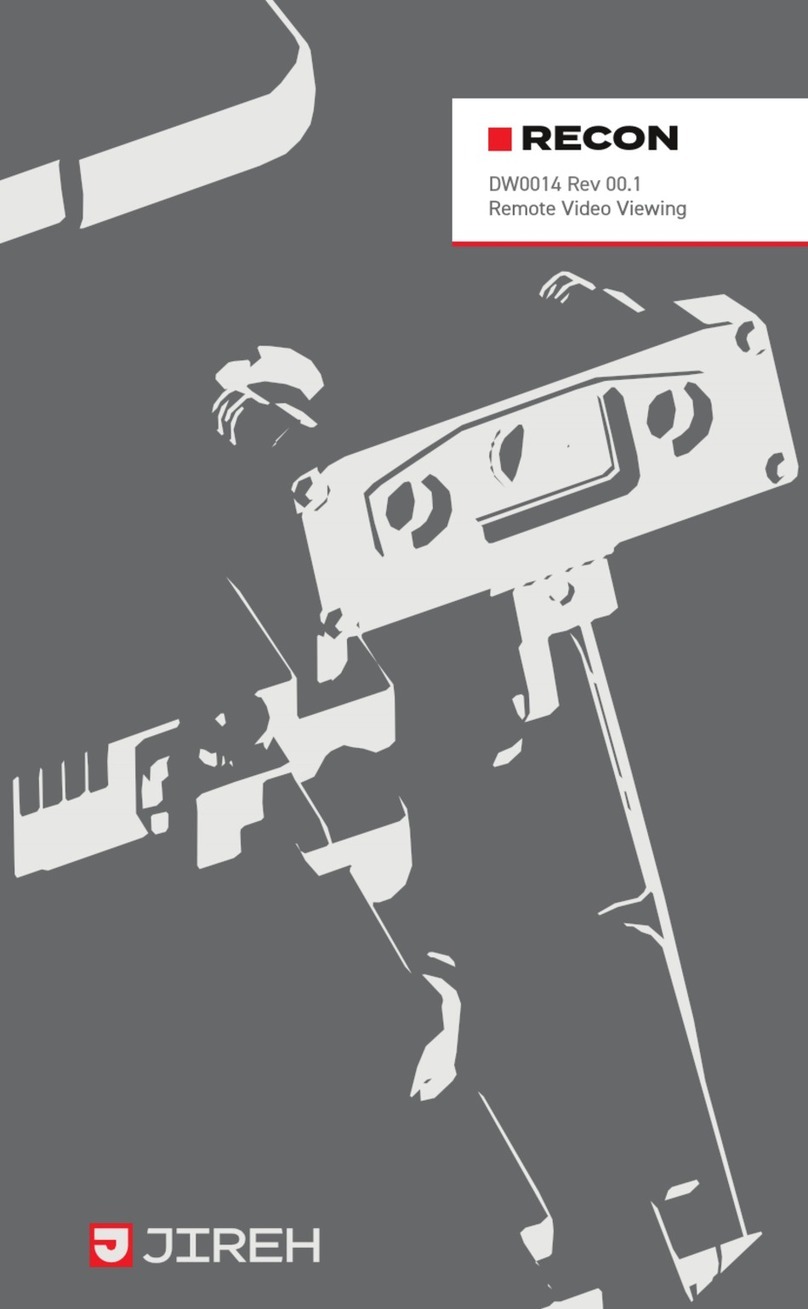
Jireh
Jireh RECON DW0014 user manual
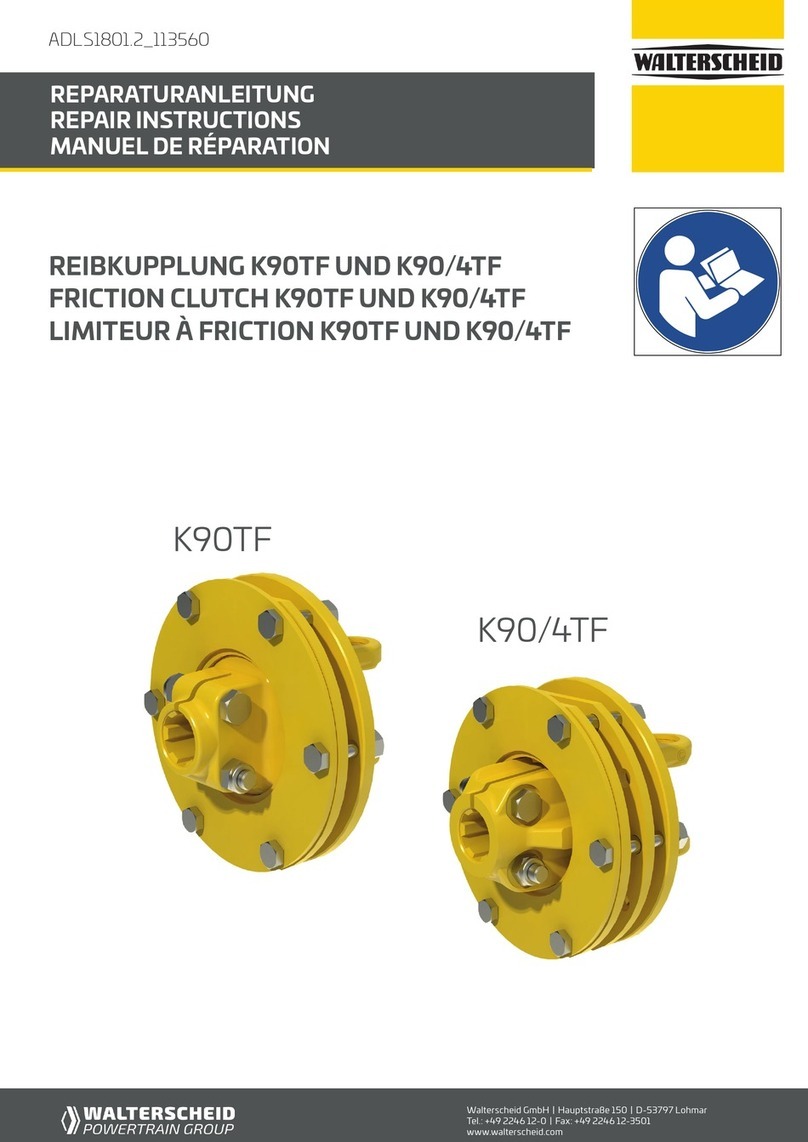
WALTERSCHEID
WALTERSCHEID K90TF Repair instructions
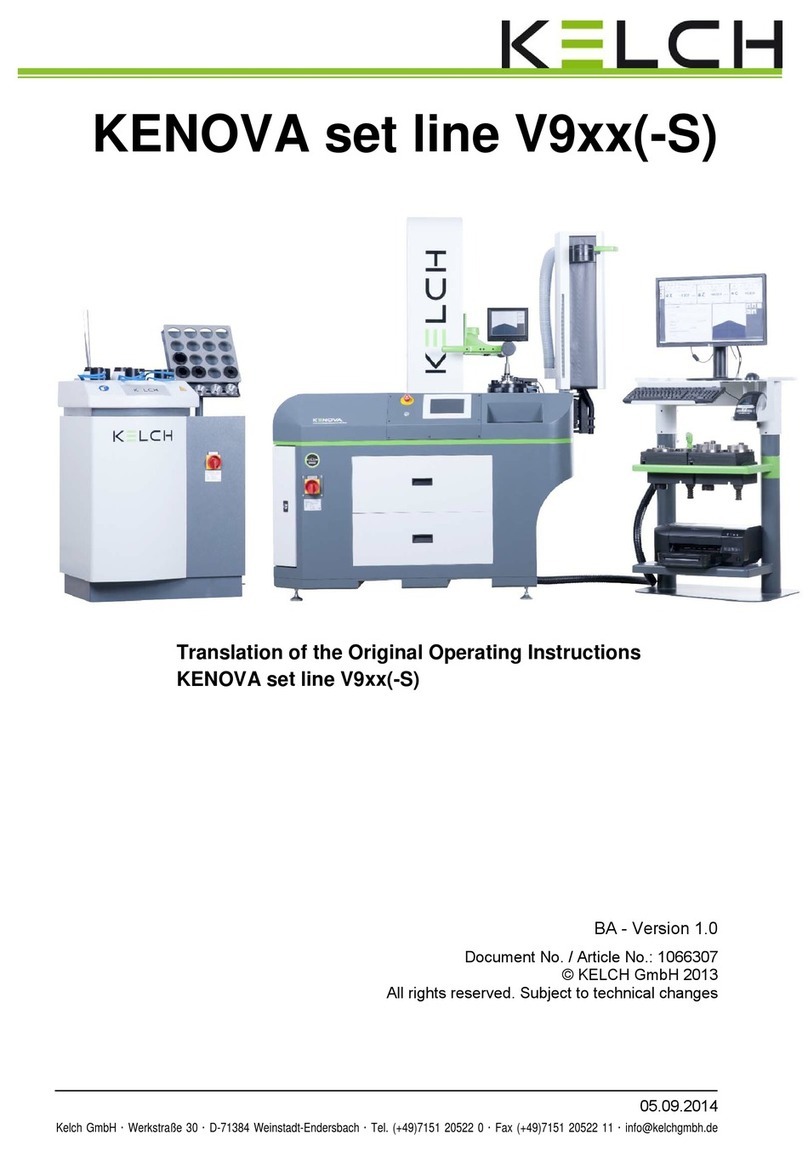
KELCH
KELCH KENOVA set line V9 Series operating instructions
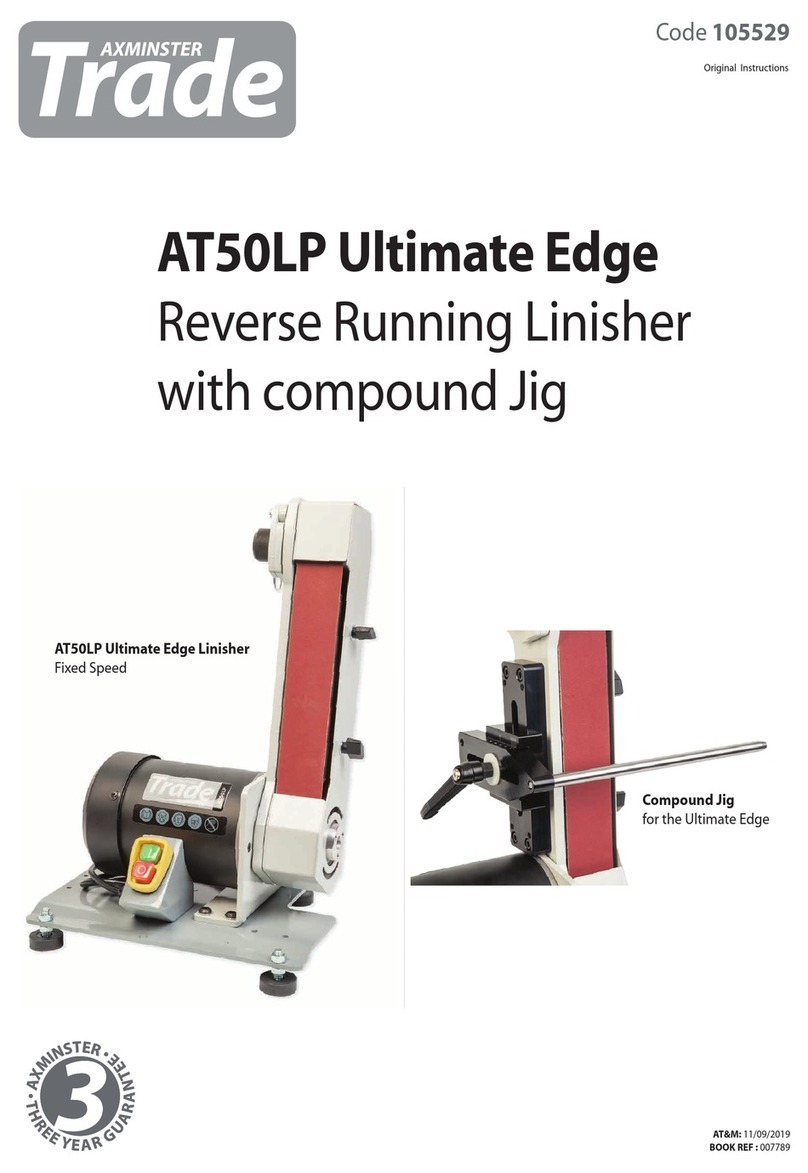
Axminster Trade
Axminster Trade AT50LP Ultimate Edge Original instructions

Makita
Makita M3602 instruction manual

ProMinent
ProMinent ProMix Series operating instructions

